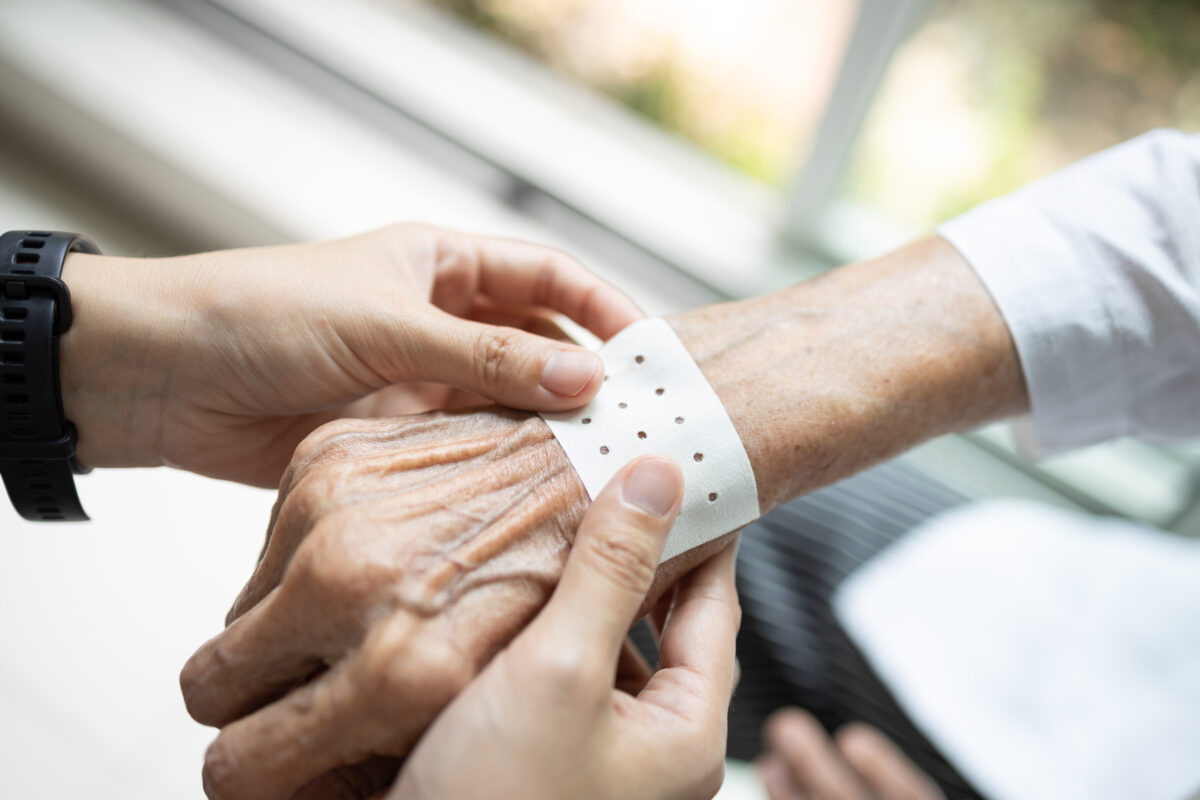Anesthesia providers are responsible for delivering anesthesia and analgesia in many contexts, ranging from perioperative to critical care.1 Some anesthesiology professionals focus their practices on treating chronic pain, such as migraine headaches, back pain or pain related to conditions like cancer or fibromyalgia.1 Approaches to chronic pain management can include ablative techniques to destroy nerves, acupuncture, nerve blocks, botulinum toxin (Botox) injections to relax muscles, electrical nerve stimulation, epidural or intrathecal drug therapies, local anesthetics, minimally invasive surgeries, pharmacologic management, physical therapy, psychologic treatment or trigger point injections.2 One approach to chronic pain is iontophoretic drug delivery, which is a noninvasive strategy to manage soft tissue pain.3 In order to provide the best chronic pain care to their patients, clinicians should understand the mechanisms of iontophoresis and its applications in anesthesiology.
Iontophoresis is defined as the facilitation of ions across a membrane.4 It is a form of transdermal drug delivery that uses electrical current to push ionized drugs through the skin’s outer layer, known as the stratum corneum.3 The stratum corneum serves as the body’s first barrier from the external environment and its functions include mechanical reinforcement, protection of cells from ultraviolet (UV) damage, regulation of immune system-regulated inflammation and hydration maintenance.5 Though these functions help protect the body, they also prevent the types of molecules that can penetrate the skin.6 Iontophoresis uses an electric current to drive hydrophilic and charged molecules through the skin barrier.6 This current can be achieved using either a positive or negative electrode, depending on the charge of the molecule that is meant to cross into the body.7 Iontophoresis is advantageous in that it can be used to deliver medications locally without injection.8 This is particularly useful for patients with fear of needles or pediatric patients.8 Additionally, iontophoresis may be useful for a variety of medications, including antibiotics.8,9 Research on iontophoresis is conflicting, as some reports argue that iontophoresis does not deliver enough medication to deep enough tissue to be effective.8 However, use of iontophoresis in dermatology, ophthalmology, dentistry and physical medicine have brought this drug delivery method to the forefront of scientific exploration.10
Iontophoresis can play various roles in analgesia, including—but not limited to—management of pain related to migraines, surgeries or cancer.11 Iontophoresis has been used for chronic pain treatment for at least 40 years.12According to Karpiński, non-steroidal anti-inflammatory drugs (NSAIDs) such as ketoprofen, ibuprofen, aspirin and indomethacin can be used in iontophoresis to relieve joint pain related to rheumatoid arthritis or other injuries.13 When applied iontophoretically, NSAIDs do not cause the usual gastrointestinal irritation that comes with their oral administration.13 Japour et al. found that acetic acid iontophoresis helped patients with chronic heel pain,14 and Osborne and Allison showed that acetic acid iontophoresis was more effective than dexamethasone in relieving pain associated with plantar fasciitis.15 Meanwhile, Yarrobino et al. found that lidocaine iontophoresis reduced pain in patients with chronic epicondylitis (tennis elbow).16 Nonetheless, the clinical efficacy of iontophoresis in chronic pain remains inconclusive; some researchers even suggest that pain relief may be due to the direct electric current, rather than the transdermal medications.17
Iontophoretic drug delivery can be employed to deliver a variety of medications across the skin barrier. Iontophoresis works by using an electric current to push charged molecules, such as medications, through the skin. In chronic pain management, iontophoresis can deliver substances ranging from NSAIDs to acetic acid to reduce symptoms. More longitudinal, prospective studies are needed to assess the benefits of iontophoretic drug delivery for pain control. Additionally, researchers should investigate the efficacy of self-powered iontophoretic systems that use biomechanical motions as an energy source.
1.American Society of Anesthesiologists. Role of Physician Anesthesiologist. When Seconds Count… Physician Anesthesiologists Save Lives 2020; https://www.asahq.org/whensecondscount/anesthesia-101/role-of-physician-anesthesiologist/.
2.Rosenquist RW, Benzon HT, Connis RT, et al. Practice Guidelines for Chronic Pain Management: An Updated Report by the American Society of Anesthesiologists Task Force on Chronic Pain Management and the American Society of Regional Anesthesia and Pain Medicine. Anesthesiology: The Journal of the American Society of Anesthesiologists. 2010;112(4):810–833.
3.Marovino T, Graves C. Iontophoresis in Pain Management. Practical Pain Management. February 21, 2011;8(2).
4.Daly SM. Biophotonics for blood analysis. In: Meglinski I, ed. Biophotonics for Medical Applications: Woodhead Publishing; 2015:243–299.
5.Murphrey MB, Miao JH, Zito PM. Histology, Stratum Corneum. StatPearls. Web: StatPearls Publishing LLC; October 30, 2019.
6.Kalia YN, Naik A, Garrison J, Guy RH. Iontophoretic drug delivery. Advanced Drug Delivery Reviews. 2004;56(5):619–658.
7.Forrester JV, Dick AD, McMenamin PG, Roberts F, Pearlman E. General and ocular pharmacology. In: Forrester JV, Dick AD, McMenamin PG, Roberts F, Pearlman E, eds. The Eye (Fourth Edition): W.B. Saunders; 2016:338–369.e331.
8.Merrick MA. Therapeutic Modalities As an Adjunct to Rehabilitation. In: Andrews JR, Harrelson GL, Wilk KE, eds. Physical Rehabilitation of the Injured Athlete (Fourth Edition). Philadelphia: W.B. Saunders; 2012:104–142.
9.Mohammed MI, Makky AMA, Teaima MHM, Abdellatif MM, Hamzawy MA, Khalil MAF. Transdermal delivery of vancomycin hydrochloride using combination of nano-ethosomes and iontophoresis: In vitro and in vivo study. Drug Delivery. 2016;23(5):1558–1564.
10.Nayak AK, Dey S, Pal K, Banerjee I. Iontophoretic drug delivery systems. In: Pal K, Kraatz H-B, Khasnobish A, Bag S, Banerjee I, Kuruganti U, eds. Bioelectronics and Medical Devices: Woodhead Publishing; 2019:393–420.
11.Pontrelli G, Lauricella M, Ferreira JA, Pena G. Iontophoretic transdermal drug delivery: A multi-layered approach. Mathematical Medicine and Biology: A Journal of the IMA. 2016;34(4):559–576.
12.Csillik B, Knyihar-Csillik E, Szucs A. Treatment of chronic pain syndromes with iontophoresis of vinca alkaloids to the skin of patients. Pain. 1983;16(2):212.
13.Karpiński TM. Selected Medicines Used in Iontophoresis. Pharmaceutics. 2018;10(4):204.
14.Japour C, Vohra R, Vohra P, Garfunkel L, Chin N. Management of heel pain syndrome with acetic acid iontophoresis. Journal of the American Podiatric Medical Association. 1999;89(5):251–257.
15.Osborne HR, Allison GT. Treatment of plantar fasciitis by LowDye taping and iontophoresis: Short term results of a double blinded, randomised, placebo controlled clinical trial of dexamethasone and acetic acid. British Journal of Sports Medicine (BJSM). 2006;40(6):545–549.
16.Yarrobino TE, Kalbfleisch JH, Ferslew KE, Panus PC. Lidocaine iontophoresis mediates analgesia in lateral epicondylalgia treatment. Physiotherapy Research International. 2006;11(3):152–160.
17.Press JM, Bergfeld DA. Physical Modalities. In: Frontera WR, Herring SA, Micheli LJ, Silver JK, Young TP, eds. Clinical Sports Medicine. Edinburgh: W.B. Saunders; 2007:207–226.



